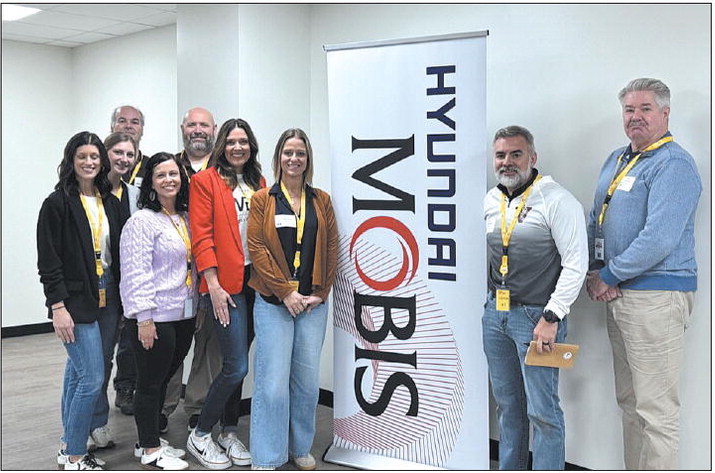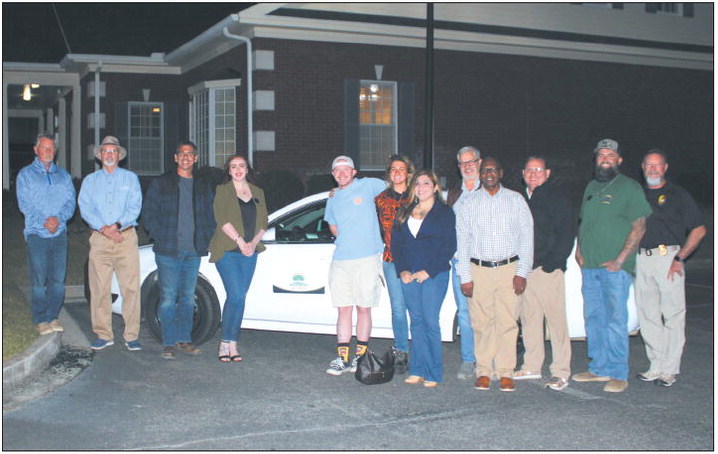continued from page According ….
continued from page
According to O’Shaughnessey, the Port of Savannah is the “South Atlantic Gateway of Choice” for imports, which is why it sees a large amount of commerce. He told the crowd that commerce has been greatly delayed throughout the COVID pandemic but had returned to normal. The number of vessels at anchor waiting to dock at the port had decreased from over 30 ships last fall to a single ship currently. Yet, he explained that the port is facing a new challenge: dispersion of imports throughout the country. “Currently, we have around 80,000 containers at the Garden City Terminal. We would much rather that number be around 65,000 containers,” O’Shaughnessey commented.
To resolve this issue, the Georgia Ports Authority has created two plans of action: one immediate solution to the problem and one long-range solution to the issue.
Immediate Solution
To presently deal with the conflict, the Port of Savannah has developed several pop-up shipping yards, as well as the Mason Megarail transportation system.
The pop-up yards are in several locations throughout Georgia, such as Statesboro, Dillard, Hulsey, and Appalachian Regional Port, as well as Huntsville, Alabama, and Rocky Mount, North Carolina. These newly-created yards were placed in abandoned railyards and other already accessible areas; the yards serve to store shipping containers and to help to speed transportation of goods to their locations.
“With the current supply chain crisis the nation is facing, as well as the storage space issues within the Port of Savannah, the pop-up yards have helped to alleviate stress from the port and consumers,” O’Shaughnessey explained. “These locations are strategically placed along interstates and highways, so that trucks may move these goods quickly to their destinations.”
The Mason Megarail is another method the Port of Savannah uses to transport goods quickly from the Port to consumers. This railway system features 10 new railways, bringing the total number to 19 different rails in the Garden City Terminal, which became fully operational in 2021.
This new development leads the industry in “ship to rail transition time,” since it takes 24 hours for imported shipping containers to be transferred to trains for further shipment. This railway system has improved connection between the southeastern terminal to the midwestern areas beyond Dallas and Memphis, and has increased railway transport capability to over one million containers per year.
Another project that the Port of Savannah is using to address immediate needs of the facility is the Peak Capacity Project, which will grow Savannah’s container storage capacity by 60%. Currently, the project, which is conducted by Georgia Ports Authority, has already increased the amount of handling space at the Garden City Terminal by an additional 400,000 shipping containers, also known as Twenty- Foot Equivalent units or TEUs. It is expected to make room for 820,000 more TEUs by June, and will add 1.7 million TEUs by 2025.
O’Shaughnessey also discussed the Savannah Harbor Expansion Project, which will cost $706 million, $194,277 of which is funded by University of Georgia Marine Extension and Georgia Sea Grant. The project will dredge 32 miles of the Savannah River, equipping it for larger vessels. “Our ports conduct business regularly, and making the waterways accessible for larger ships only increases commerce that comes to Georgia,” he said.
Midterm Solutions
He shared that the midterm solutions for the issues the Port is facing is to connect the Garden City Terminal with Chatham Yard to help the transition from sea travel to railway or roadway travel, the creation of a “T” cross deck in the Port to be able to more effectively organize TEUs when removing from ships, as well as the correction of Berth I. Berth I in the Port of Savannah needs to be realigned to correct a gradual shift the facility has faced throughout time. To do this will take a total of 3 years, but will benefit the Port by allowing the Berth to process 1.2 million more TEUs annually. Overall, a total of $100 million will be spent on these midterm projects.
“Georgia has been the top state for doing business for 8 years – it has the space for industry development, and has the top market for warehouse absorption in the state,” O’Shaughnessey emphasized. “Our Port must adapt to the times to ensure that we continue to work at our best.” Following this conclusion, O’Shaughnessey held a question and answering session with the Kiwanis Club, and discussed topics such as the revitalization of railway usage, the possibility of further dredging in the Savannah River, and many other undetermined future options for the facility.

ALTAMA KIDS ART DAY — The Altama Museum of Art and History hosted a Kids Art Day on March 28 to showcase local students’ art. The event also featured many hands-on art activities for children to participate in, as seen here where a volunteer helps a participant with a craft.







